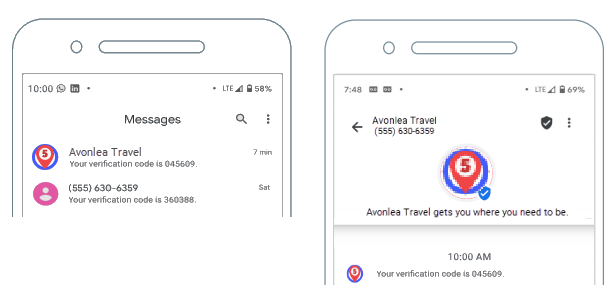Verified SMS for Android allows you to send branded SMS messages to your customers who use Android devices. Verified SMS messages include your organization's name, logo, and a tag line or description. They also include the Google verified sender badge. Because customers know who is sending the message, they're more likely to open it. They're also more likely to engage with your organization.
CXone uses Google's Verified SMS API![]() APIs allow you to automate certain functionality by connecting your CXone system with other software your organization uses. to verify that your organization is the sender. Verified SMS messages look much different from other SMS messages:
APIs allow you to automate certain functionality by connecting your CXone system with other software your organization uses. to verify that your organization is the sender. Verified SMS messages look much different from other SMS messages:
- In the list of received messages in the customer's messaging app, verified SMS messages show your company name instead of the phone number that sent the message. They also include your organization's logo instead of a generic sender icon.
- The top of the message becomes a "conversation start card," which displays your organization's name, logo, and the Google verified sender badge.
- The message you send begins beneath the conversation start card. The time stamp that appears with each message includes your organization's name as well as the time.
- If your messages include any URLs, verified SMS messages display a preview of the URL.
Only customers using Android devices can see these differences. To customers using other platforms, such as iOS, they appear the same as other SMS messages they receive. The messages don't include a logo or your organization's name. They also don't include the Google verified badge.
You can set up and enable verified SMS for any CXone SMS option, including omnichannel![]() The ability to work on multiple interactions from different channels at the same time. SMS, Personal Connection Proactive SMS and Digital First Omnichannel SMS.
The ability to work on multiple interactions from different channels at the same time. SMS, Personal Connection Proactive SMS and Digital First Omnichannel SMS.
Anne Shirley is the administrator of Avonlea Travel, a division of Classics, Inc. She configures CXone to send verified SMS messages. She knows that her customers are more likely to trust messages if they know who sent them. Seeing the company name and logo make it obvious who sent the message. The Google verified badge adds to the trustworthiness of the message. Anne expects that Avonlea Travel's marketing campaigns will see increased effectiveness now.
Key Facts about Verified SMS for Android
- Customers not on Android devices still receive the same messages. The messages have the same content, but they appear as they usually do for the customer's device. They don't include the verified sender badge.
- Before this feature will work, Google must verify the brand's details. You must provide the name and email address of a company representative and your company's public website to Google. Google contacts this person. After Google authorizes the brand, verified SMS is completely set up and enabled.
- If your organization represents more than one brand or division with separate identities, you can create a brand for each entity. Each brand can have its own logo, name, and description. If you need a brand to be localized for additional languages, you must create a separate brand listing for each language you require. Every brand you create in CXone verified SMS requires separate verification by Google.
- You need to provide logos for the brands you configure. In SMS messages, logos display in 224 px diameter circles. All logos must be hosted publicly. You need the URL for the image when you configure verified SMS. Logo files must be 224 x 224 px, JPG or PNG format, and no more than 50 KB.


